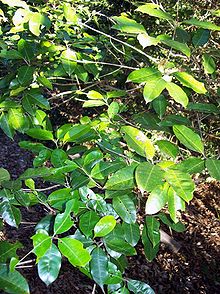- Olea paniculata
-
Olea paniculata 
Scientific classification Kingdom: Plantae Division: Magnoliophyta Class: Magnoliopsida Order: Lamiales Family: Oleaceae Genus: Olea Species: O. paniculata Binomial name Olea paniculata
R.Br. [1]Synonyms[2] - Linociera yunnanensis H.T.Chang
- Olea glandulifera Desf.
Olea paniculata, commonly known as the Native Olive, is a plant of the genus Olea and a relative of the olive. It is found from Yunnan in southwestern China and Pakistan across southern Asia to Australia and New Caledonia, Vanuatu and Lord Howe Island in the Pacific Ocean.
Contents
Taxonomy
One of many species first described by Robert Brown in his 1810 work Prodromus Florae Novae Hollandiae, it still bears its original binomial name. Other common names include Australian Olive, Pigeonberry Ash, Maulwood, and Clove berry.[3] In Chinese, it is called 腺叶木犀榄 (pinyin: xiànyè mùxī lǎn).[4] The specific name is derived from the Latin panicula "tuft", from the arrangement of flowers.[5]
Description
It grows as a bushy tree to 30 m (100 ft), often with a sparse canopy. The trunk has smooth grey-brown bark and reaches a maximum diameter of 90 cm (36 in) with some buttressing.[5] The shiny green ovate to elliptical eaves measure 5–10 cm (2–4 in) in length, and1.5–6 cm (0.6–2.4 in) in width, and have a pointed (acuminate) end. The blue-black fruit are oval and measure 0.8–1.2 (0.3–0.5 in) cm long. [6] They are ripe from May to September.[5]
It resembles the introduced and weedy African olive Olea europaea subsp. cuspidata, but the latter lacks O. paniculata's small depressions between the main and secondary veins on the back of the leaf. The introduced species is found in disturbed areas such as roadsides and waterways.[7]
Distribution and habitat
Olea paniculata is found from North East Queensland to the vicinity of the Hunter Valley in Central New South Wales.[6] In Australia it is found near watercourses in dry rainforests.[5] Outside australia it is found in Yunnan province in southwestern China, where it occurs in sheltered wetter valleys 1200-2400 m (4000-8000 ft) in altitude, as well as India, Indonesia, Kashmir, Malaysia, Nepal, New Guinea, Pakistan, and Sri Lanka.[4] On Lord Howe Island it is widespread below around 500 m (1500 ft) elevation. It is also found on New Caledonia and Vanuatu.[8]
Ecology
The fruit are consumed by the Australian King Parrot, Brown Cuckoo-dove, Topknot Pigeon, Rose-crowned Fruit-dove, Wompoo Fruit-dove, White-headed Pigeon, Green Catbird and Regent Bowerbird in Australia.[5]
Uses
It is a fast pioneer species on sunny protected sites, but needs well drained soil for good growth. Bird attracting black fruit. Butterfly host plant.
References
- ^ Olea paniculata was first described and published in Prodromus Florae Novae Hollandiae 523. 1810. "Name - Olea paniculata R.Br.". Tropicos. Saint Louis, Missouri: Missouri Botanical Garden. http://www.tropicos.org/Name/23000422. Retrieved October 28, 2011.
- ^ "Name - Olea paniculata R.Br. synonyms". Tropicos. Saint Louis, Missouri: Missouri Botanical Garden. http://www.tropicos.org/Name/23000422?tab=synonyms. Retrieved October 28, 2011.
- ^ "Olea paniculata R.Br.". Australian Plant Name Index (APNI), IBIS database. Centre for Plant Biodiversity Research, Australian Government. http://www.anbg.gov.au/cgi-bin/apni?taxon_id=49352.
- ^ a b "Olea paniculata R. Brown, Prodr. 523. 1810.". Flora of China – eFloras Online. 2008. http://www.efloras.org/florataxon.aspx?flora_id=2&taxon_id=210001345. Retrieved 2010-06-02.
- ^ a b c d e Floyd, Alex G. (2009). Rainforest Trees of Mainland Southeastern Australia. Lismore, NSW: Terania Rainforest Publishing. p. 278. ISBN 09589443673.
- ^ a b Hardin DW. "Olea paniculata L.". PlantNET – NSW Flora Online. http://plantnet.rbgsyd.nsw.gov.au/cgi-bin/NSWfl.pl?page=nswfl&lvl=sp&name=Olea~paniculata. Retrieved 2010-06-02.
- ^ [1]
- ^ [2]
Categories:- Olea
- Lamiales of Australia
- Flora of Queensland
- Flora of New South Wales
- Flora of Lord Howe Island
- Plants described in 1810
Wikimedia Foundation. 2010.
